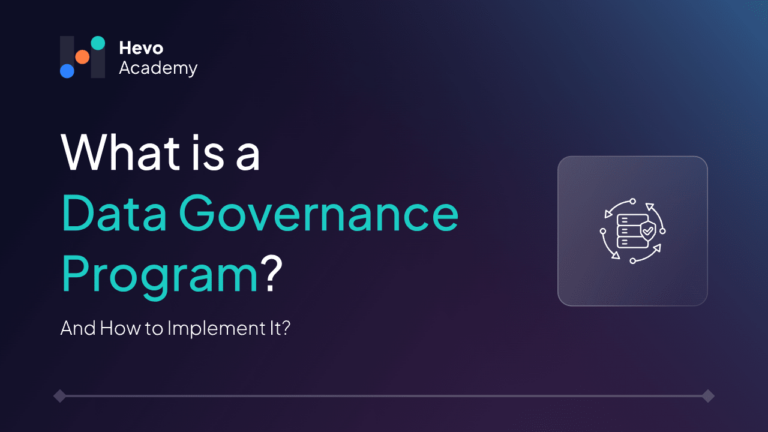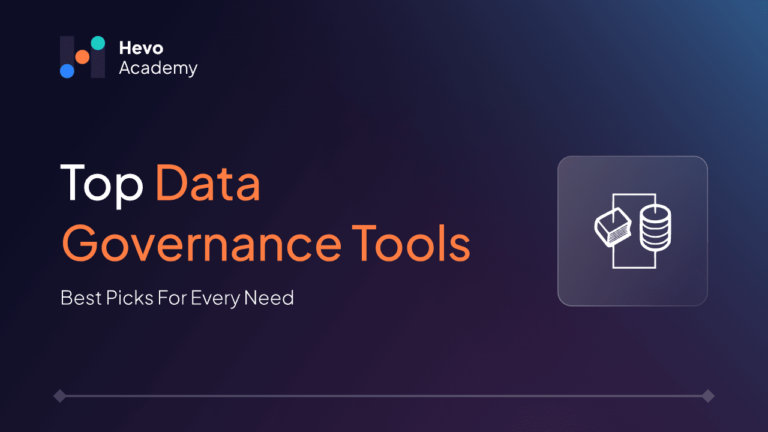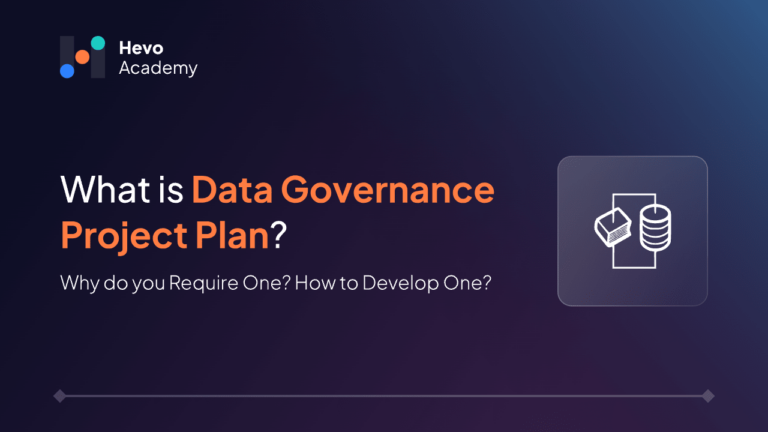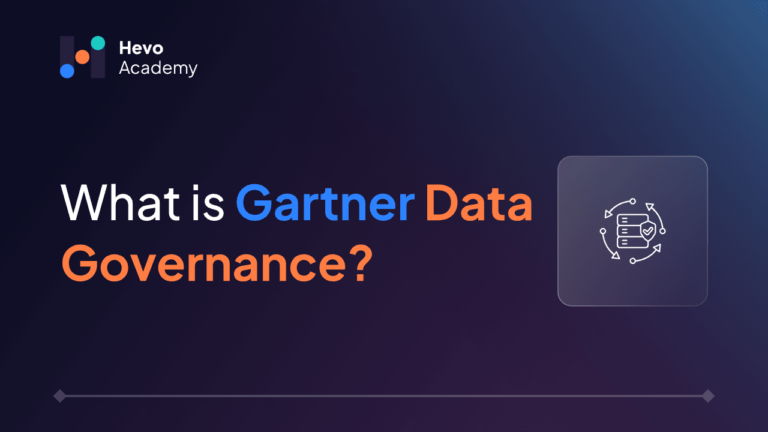Organizations can assess a strategy’s efficacy through data. A company’s ability to succeed can be greatly impacted by its decisions, which is why high-quality data is so important. A data governance program provides a structured framework to manage, protect, and utilize data across the organization.
Table of Contents
This article will discuss the key components of data governance, its importance, the steps to implement a data governance program, best practices for creating an effective data governance program, challenges that arise while implementing data governance, and strategies for resolving these errors.
What is Data Governance?
Data governance provides standards and rules that help organizations control, protect, and manage data. It increases data quality to ensure that it is accurate, consistent, and secure. For example, healthcare businesses implement data governance to protect their patient information and ensure compliance with the Health Insurance Portability and Accountability Act (HIPAA).
Key Components of Data Governance
Here are the five key components of data governance:
1. Data governance strategy
The objectives of a data governance program should be defined. The strategy includes targets to be reached to monitor progress, success metrics, and business cases that describe the impact of ungoverned data on business.
2. Data governance roles and responsibilities
In most organizations, many individuals participate in the data governance process. These include business leaders, data management specialists, and IT personnel who are conversant with relevant information fields within a company’s systems.
3. Data governance policies and processes
Data governance policies help ensure that data is managed in compliance with applicable laws. Data processes are used to enforce policies and rules. Data governance programmes need to create essential data processes, including data issue tracking and data quality surveillance.
4. Data quality management
Data quality management includes processes and methodologies to maintain and improve data completeness, consistency, and accuracy. Without confidence in data, organizations cannot make significant business decisions, which results in inefficiencies and, eventually, financial loss.
5. Data stewardship
Data stewardship refers to managing changes in data assets. It ensures data accuracy, reliability, and quality. Data stewards collaborate with various staff members, including database administrators, data quality analysts, and other data management professionals.
Ditch the manual process of writing long commands to migrate your data and choose Hevo’s no-code platform to streamline your migration process to get analysis-ready data.
With Hevo:
- Transform your data for analysis with features like drag and drop and custom Python scripts.
- Migrate data from 150+ connectors(including 60+ free sources).
- Eliminate the need for manual schema mapping with the auto-mapping feature.
Try Hevo and discover how companies like EdApp have chosen Hevo over tools like Stitch to “build faster and more granular in-app reporting for their customers.”
Get Started with Hevo for FreeWhy is it Necessary to Implement Data Governance?
Understanding data governance helps reduce risks related to data compliance, data quality, and security and prevents security breaches. It also helps manage data to make strategic business decisions and assign responsibilities among employees. Data governance greatly impacts overall data strategy, managing data quality, and ensuring compliance with rules and regulations.
What is a Data Governance Program?
A data governance program is an operational implementation of data governance for managing data assets in an organization. This program implements rules, standards, processes, and policies for using data and ensures that the process of dealing with data complies with regulations.
Objectives of a Data Governance Program
- Protecting private and sensitive information from any unauthorized access or exploitation.
- Assigning tasks and responsibilities to all required team members.
- Make sure that private information is only available to authorized users.
- Establishing clear policies and procedures for data collection, storage, processing, retention, and destruction.
- Providing precise and dependable data to support critical business choices.
- Reducing risk associated with non-compliance with regulations
Benefits of a Data Governance Program
- Protects sensitive and private information by applying access controls.
- Reduces costs related to analyzing poor data quality and security breaches.
- Ensures that decisions are based on accurate, usable, secure, and reliable data.
- Ensures that organizations comply with rules and regulations.
- Ensures data is consistent and standard across all departments of an organization.
- Reduces any data redundancies and incorrectness.
- Increases accountability by assigning roles and responsibilities.
Steps to Implement a Data Governance Program
Implementing a data governance program is an incremental process. There are 7 steps to implement a data governance program.
1. Define your data governance goals, objectives, and data strategy
Start by defining both long-term and short-term strategic goals of the organization. A data strategy will define data requirements, stakeholders, data management processes, technological priorities, and skills across numerous business objectives.
For example, an effective data governance program improves data quality that can result in more accurate and reliable decision-making, Increased data security to protect sensitive information, and enable compliance and reporting against industry regulations
2. Secure executive support and essential stakeholders
Determine who should be included in implementing the data governance program. Also, identify the key players and responsibilities that need to be identified. After finalizing key sponsorship and executive, define what needs to be accomplished and raise awareness on how to create a model for funding.
Implementing a data governance program can give your company a strategic edge by recognizing and providing obvious business value, as well as by effectively engaging key stakeholders. Stakeholders help in securing funding and strategic decision making.
3. Assess, build, and refine your data governance program
After defining business objectives and deciding who will be stakeholders and sponsors, the next step is assigning these objectives to existing processes, people and technology.
Assess your data governance program. Some data management frameworks, like EDM council’s DCAM and CDMC, offer structured ways to assess your data ecosystem and check your data maturity against industry benchmarks. Check how data is managed and governed, its strengths and weaknesses, and identify areas for improvement.
4. Document your organization’s data policies.
A documented collection of principles known as data policies establishes uniform standards for the governance, management, protection, and use of an organization’s data assets. Data policies ensure that the use of your data aligns with applicable legal requirements and advances your company’s overarching objectives.
5. Establish roles and responsibilities.
Establish precise roles and duties for all parties in data governance, including those in charge of gathering, storing, and utilizing data. This will guarantee that everyone is aware of their responsibilities and is able to contribute to the data governance endeavor in a meaningful way. Depending on the organization, data governance may be integrated into current roles and responsibilities in a small organization, it may be overseen by a specialized team in a large enterprise.
6. Develop and refine data processes.
Data governance procedures facilitate standard data management practices and guarantee sound decision-making by bringing together teams from within and outside your company. They can also safeguard sensitive data and guarantee adherence to legal requirements. Procedures for data governance should be simple enough to accomplish your company objectives without creating needless obstacles or stifling creativity.
7. Implement, evaluate, and adapt your strategy.
After defining the components of your data governance program, it’s time to put them in action. Implement new technologies or processes or make changes to existing ones if needed. Regularly monitor and review your strategy to ensure that it is meeting your goals and business objectives. Evaluate your goals and objectives continuously and adjust them when needed.
Best Practices to Create an Effective Data Governance Program
Some of the best practices to create an effective data governance program include:
- Defining data governance goals, objectives, and data strategy according to business needs to increase data quality
- Securing executive support and essential stakeholders for the organization
- Assessing, building, and refining data governance programs to enhance business growth
- Documenting the organization’s data policies to make sure data aligns with legal requirements
- Establishing roles and responsibilities within the organization to increase accountability
- Developing and refining data processes to accomplish company objectives.
- Implementing, evaluating, and adapting the organization’s strategy according to business needs
Learn about Data Governance Best Practices in detail from our blogs.
Challenges in Implementing a Data Governance Program
Implementing a data governance program can result in challenges across the organizations, such as:
- Limited resources, including staff, technology, and budget.
- Resistance to change among employees in how data is managed.
- Shortage of people in a team with the required data governance expertise.
- A lack of knowledge about the importance of data governance.
- Inconsistencies in data formats across different departments of an organization.
There are various strategies to overcome these challenges within an organization. These strategies include:
- Effectively communicating the value and benefits of the program to all stakeholders
- Enforce data standards across the organization.
- Ensure that the program has enough staff, technology, and budget.
- Providing training and support to employees who are responsible for implementation
- Involving key decision-makers in the planning process.
To know more about How to Overcome Data Governance Challenges, check out our blog.
Conclusion
The data governance program creates a clear framework to ensure that data management practices comply with legal requirements and standards. Data governance programs implement effective data governance practices that are essential for collecting, processing, managing, protecting, and storing data assets. By following data governance programs, organizations can leverage the right tools to establish strong data governance that enhances data quality, security, and usability. Data governance identifies how data is handled and protects sensitive information. Data governance programs help organizations maximize the value of their data while mitigating risks and ensuring regulatory compliance.
To get the most out of your data, migrate it seamlessly using Hevo. Sign up for Hevo’s 14-day free trial and enhance your data migration game.
Frequently Asked Questions
1. What are the four components of data governance?
Data governance includes four components: data stewardship, data governance policies, data governance processes, and data protection.
2. What are the critical components of data governance?
Data governance includes data stewardship, data governance policies, data governance processes, and data quality management, which are critical components.
3. What are the strong data governance strategies?
Some strong data governance strategies include defining clear and concise objectives, implementing effective tools, developing comprehensive policies, and creating a culture of data stewardship.
4. What is data governance in a nutshell?
Data governance is defining roles and complying with policies and procedures to manage data quality, availability, integrity and security.






